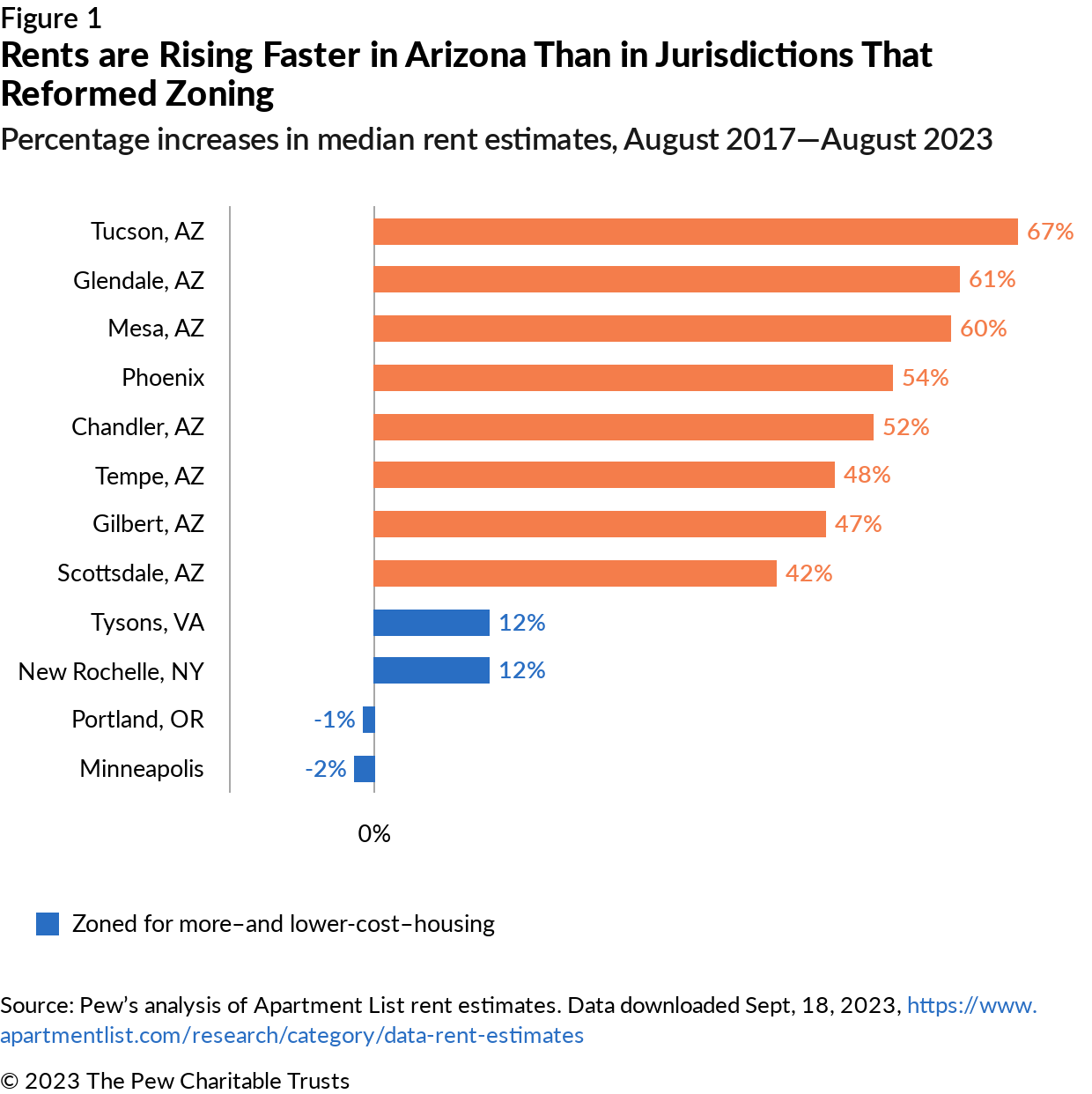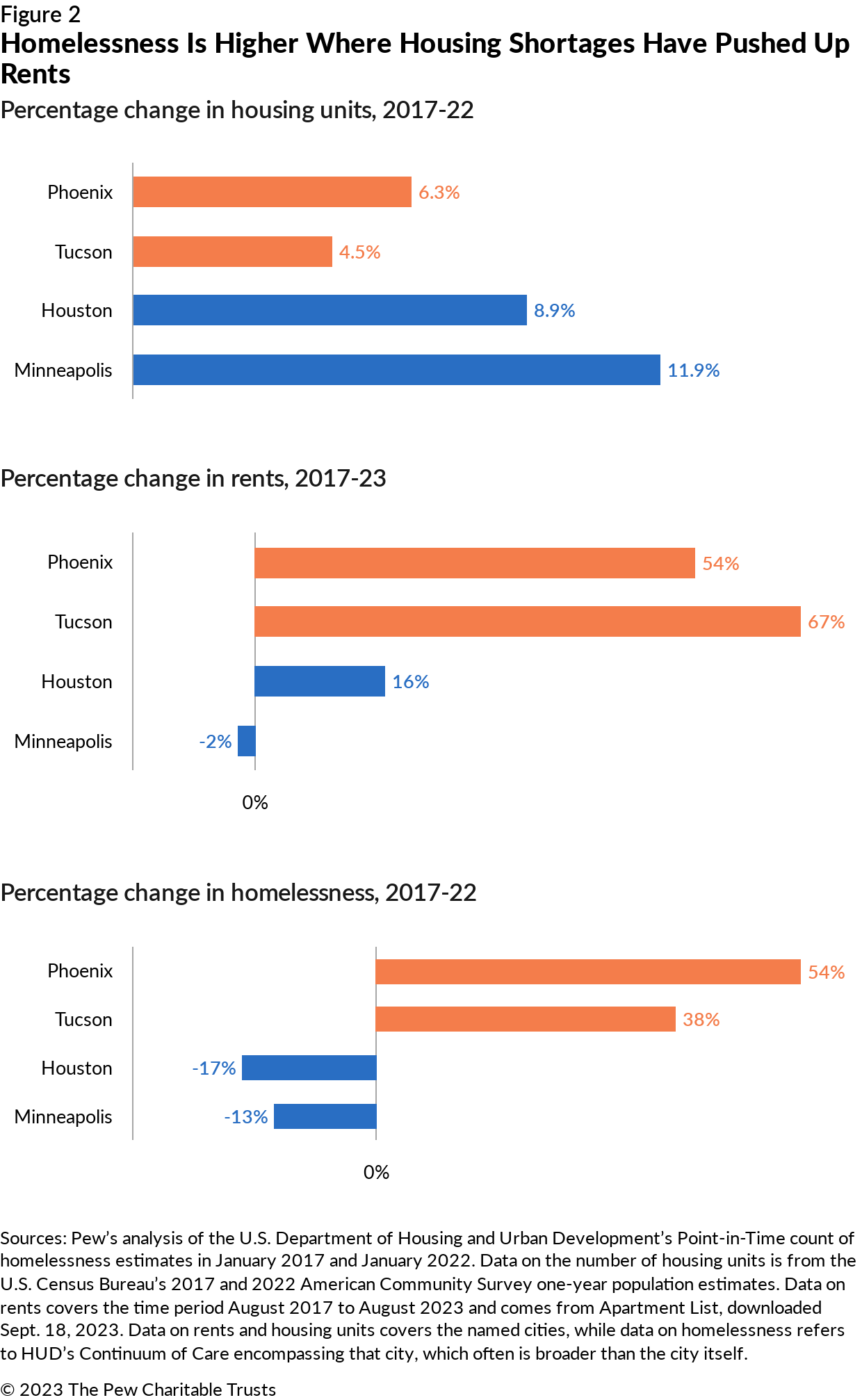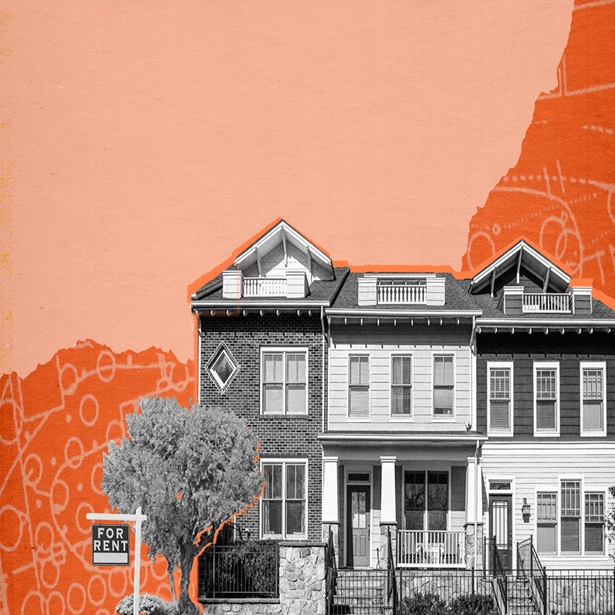Restrictive Zoning Is Raising Housing Costs and Homelessness in Arizona
However, jurisdictions with updated regulations that allow more housing have held down rents

Arizona policymakers, like their peers in other states, are considering how to respond to a nationwide housing shortage that is pushing rents and housing costs to record levels. From August 2017 to August 2023, rental prices across Arizona surged by 53%, with even higher percentages in Tucson, Mesa, Glendale, and Phoenix. Although Arizona has long been known for its affordability, 53% of Phoenix-area renters in multi-family housing are now cost-burdened, spending 30% or more of income on rent. Spiking costs hurt homebuyers too: The monthly cost of homeownership (excluding the 2022-23 increase in interest rates) for the average home in Arizona increased by 73%, from $1,750 in August 2017 to $3,032 in August 2023. And for first-time homebuyers in Arizona, a family earning $55,000 would have been able to afford the monthly mortgage payment on an average entry-level home in 2017, but a family would have to earn $99,500, to afford the monthly payment for the same home this year.
What’s driving Arizona’s steep increase in housing costs? Studies show that rental prices rise faster when there is a scarcity of available homes, as low vacancy rates intensify competition for available units. It’s the same in the for-sale market, where shortages cause prices to climb swiftly. The monthly inventory of homes for sale in the three most populated regions of Arizona dropped by 40% in the Phoenix area, and by 49% and 32% in and around Tucson and Prescott, respectively, from August 2018 to August 2023. One study found that home prices in the Phoenix area have risen 216% since 2000, while wages have risen just 48%.
Fundamentally, Arizona has too few homes available for sale or rent. The state’s population grew 14.7% from 2010 to 2022, but its housing stock increased by only 11.9%. Various sources have estimated an existing shortage of approximately 100,000 homes. Furthermore, in 2022, Arizona recorded an all-time low average household size of 2.53 individuals, with 63% having just one or two people. With smaller households, more homes would be needed even if Arizona hadn’t gained nearly 350,000 residents since 2017.
There is evidence that strict land-use regulations are contributing to this housing shortage and driving up rents and sale prices. Throughout Arizona, numerous cities and towns reserve substantial portions of residential land for the construction of the most expensive housing: single-unit detached homes, often with large lots and substantial parking requirements. Conversely, housing options such as duplexes, townhomes, apartment buildings, and those with less parking typically offer more affordable rental rates and sales prices than single-unit detached homes. However, local zoning codes that limit where multifamily housing can be built or the number of homes per acre have made it difficult to develop lower-cost housing. For example, the Morrison Institute at Arizona State University has noted that in Tucson, multifamily housing can be built only on 12% of the land. Similarly, Phoenix’s general plan allows only low-density housing of no more than five homes per acre in many areas.
Certain U.S. jurisdictions have revised their zoning codes to tackle housing shortages, curb cost escalation, and make homeownership more accessible. Notable examples include Minneapolis; New Rochelle, New York; Portland, Oregon; and Tysons, Virginia. A Pew analysis found that zoning reforms in these jurisdictions (which are also growing) have enabled far more housing than the national average while mitigating the growth of rental prices. By contrast, in Arizona’s cities and towns, rents have surged over the past six years. (See Figure 1.)
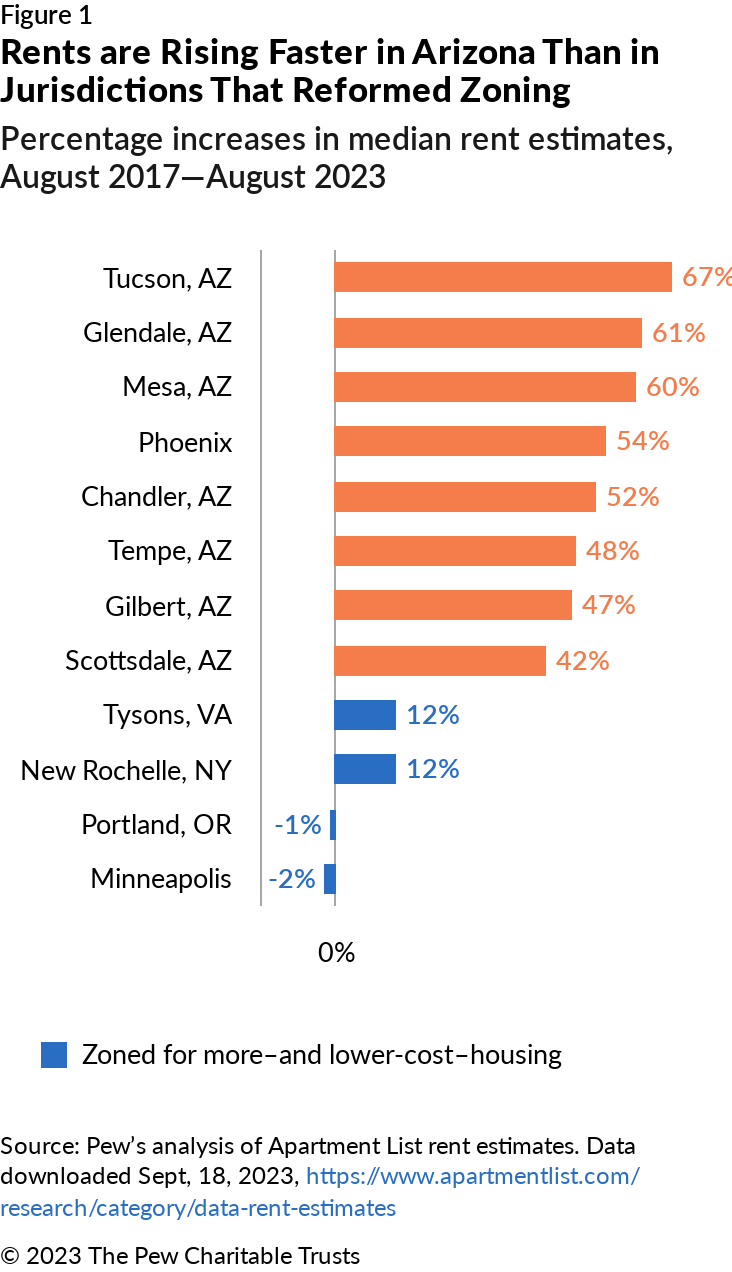
High housing costs strain household finances and contribute to a rise in homelessness. A large body of academic research has consistently found that homelessness is primarily driven by housing costs, not substance use disorder, mental health, weather, the strength of the social safety net, poverty, or economic conditions. Furthermore, homelessness increases when rents rise by more than low-income households can afford, and shortages tend to cause rents to increase fastest in lower-income neighborhoods. In Arizona, as rents climbed, homelessness increased by 51.5% statewide from 2017 to 2022, compared with a nationwide increase of 5.7%. Analyzing the Phoenix, Tucson, Houston, and Minneapolis regions, which have adopted diverse housing strategies, demonstrates how housing costs influence homelessness. Among these four cities, Phoenix and Tucson added less housing from 2017 to 2022 and consequently experienced steep increases in rents and homelessness. In contrast, Houston and Minneapolis enabled more homebuilding, and consequently homelessness dropped as rent growth stayed low. (See Figure 2.) During this time, the number of households in Phoenix and Minneapolis grew by 9.8%, while Tucson added 7.9% and Houston 13.1%—indicating that low rent growth in Houston and Minneapolis was not due to low demand.
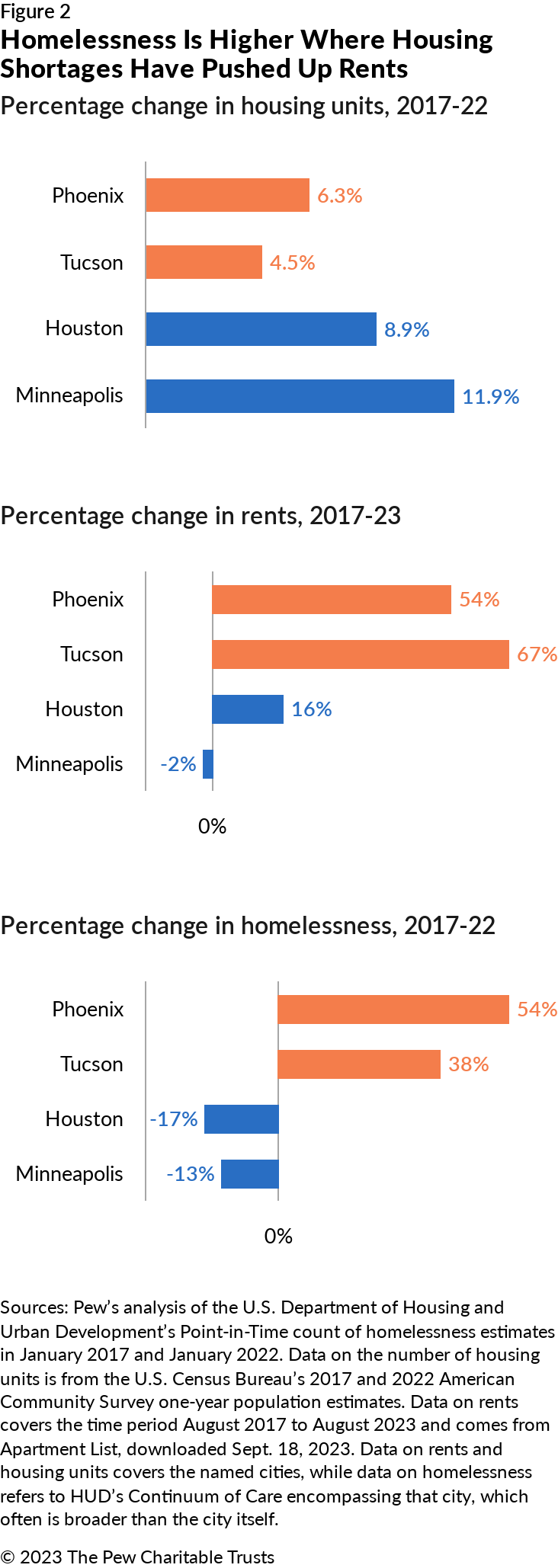
While several jurisdictions highlighted here have allowed more housing and succeeded in slowing rent growth, most places have not made these changes, and rents have risen. But California, Massachusetts, Montana, Oregon, and Utah, among other states, are taking action. As an example, reforms that Montana enacted in 2023 include allowing accessory dwelling units (ADUs), duplexes, apartments in commercial areas, simplification of permitting, and creation of a menu of policies that cities must choose from to increase housing. Although Arizona lawmakers introduced a bill in 2023 to enable more housing, the legislation did not pass. Some of Arizona’s cities, including Tucson and Phoenix, allow construction of ADUs (also called casitas), and in September 2023, Phoenix strengthened its local law to make it easier to build ADUs. However, observers note that numerous regulatory barriers limit ADU construction in Arizona.
Water scarcity has also motivated support for housing policy reform in Utah and other Southwestern states. Homes on smaller lots and multifamily homes use less water than single-unit detached homes on large lots, in part because of shared outdoor spaces requiring less water per person. A nationwide study that included data from Phoenix Water Services found that single-family homes in Phoenix used an average of 331 gallons per day, whereas each home in a multifamily development used 182 gallons per day (45% less).
Affordability has improved in jurisdictions that have allowed more housing. In an era when households are allocating more of their income toward housing costs than ever before, the success in places that have updated their zoning to constrain rent increases offers clues for improving housing affordability and reducing homelessness.
Tushar Kansal is a senior officer and Alex Horowitz is a project director with The Pew Charitable Trusts’ housing policy initiative.
